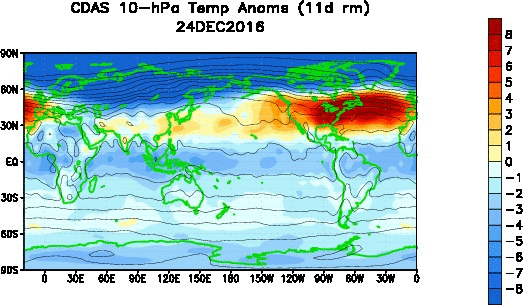9:25 AM | *Significant stratospheric warming event to set off winter’s comeback in the Mid-Atlantic region*
Paul Dorian
Loop of stratospheric (10-mb) temperature anomalies over the last 30 days on a worldwide basis with warming (orange) seen across the northern latitudes; courtesy NOAA
Overview
Our “January thaw” period is about to come to an end in the Mid-Atlantic region. A colder weather pattern will unfold over the next few days – set off by a significant stratospheric warming event near the North Pole - and it will result in rather sustained cold for the region. In fact, numerous recent years (2007, 2010, 2013, 2015) that featured major stratospheric warming events during the latter part of January generally featured significantly colder-than-normal months of February in the eastern US.
Current temperature analysis in the stratosphere (10 mb) centered over the North Pole; courtesy NOAA
Stratospheric Warming
One of the ways to monitor the potential for Arctic air outbreaks in the northern U.S. is to follow what is happening in the stratosphere over the polar region of the northern hemisphere. Sudden stratospheric warming (SSW) events are large, rapid temperature rises in the winter polar stratosphere occurring primarily in the Northern Hemisphere. They have been found to often set off a chain of events in the atmosphere that ultimately lead to Arctic air outbreaks from northern Canada into the central and eastern U.S. Indeed, there is a significant stratospheric warming event now underway and it provides support to the notion that a colder weather pattern will develop here over the next few days and it should last well into the month of February.
Forecasted stratospheric temperature pattern in 9 days at 10 mb with significant warming seen over the North Pole and a displacement of the polar vortex; courtesy NOAA
During the winter months in the lower polar stratosphere, temperatures are often as cold as -70°C Celsius (darker purple areas above). The extremely cold temperatures in the upper atmosphere are typically combined with strong westerly winds that form the southern boundary of the stratospheric polar vortex.
Temperature anomalies from 00Z GEFS for days 2-6, still above-normal in the Northeast US; courtesy tropicaltidbits.com, NOAA
The polar vortex plays a major role in determining how much Arctic air spills southward from the high latitudes to the middle latitudes. This dominant structure is sometimes disrupted in some winters or even reversed. Under these circumstances, the temperatures in the lower stratosphere can rise by more than 50°C in just a few days. In the on-going stratospheric warming event, temperatures over the North Pole are predicted to rise sharply from -65°C to -30°C over the next nine days.
Temperature anomalies from 00Z GEFS for days 7-11; courtesy tropicaltidbits.com, NOAA
This should set off a reversal in the west-to-east winds and the displacement of the polar vortex. In response to the stratospheric warming at the high latitudes, the troposphere in turn cools down dramatically and this cold air displacement is then transported from the tropospheric high latitudes to the tropospheric middle latitudes. The entire process from the initial warming of the stratospheric at high latitudes to the cooling in the troposphere at middle latitudes can take a few weeks to unfold.
Temperature anomalies from 00Z GEFS for days 12-16 with lots of cold air upstream; courtesy tropicaltidbits.com, NOAA
Model Temperature Trends
The 00Z version of the GFS ensemble forecast model shows a downward trend in temperatures over the next few weeks. The 5-day average surface temperature anomalies are shown for days 2-6, 7-11 and 12-16 and it supports the notion that we’ll move from above-normal conditions to near and then below-normal going right into the heart of February.
Meteorologist Paul Dorian
Vencore, Inc.
vencoreweather.com
Extended video discussion (below) provides general information on the "stratospheric warming" phenomenon:






